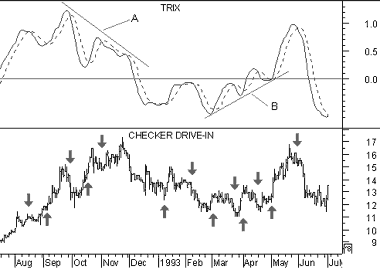|
T R I X
Overview
TRIX is a momentum indicator that displays the percent rate-of-change of a triple
exponentially smoothed moving average of the security's closing price. It is designed to
keep you in trends equal to or shorter than the number of periods you specify.
Interpretation
The TRIX indicator oscillates around a zero line. Its triple exponential smoothing is
designed to filter out "insignificant" cycles (i.e., those that are shorter than the number
of periods you specify).
Trades should be placed when the indicator changes direction (i.e., buy when it turns up
and sell when it turns down). You may want to plot a 9-period moving average of the TRIX
to create a "signal" line (similar to the MACD indicator, and then
buy when the TRIX rises above its signal, and sell when it falls below its signal.
Divergences between the security and the TRIX can also help identify turning points.
Example
The following chart shows Checker Drive-In, its 12-day TRIX (solid line), and a 9-day
"signal" moving average of the TRIX (dotted line).
 I drew "buy" arrows when the TRIX rose
above its signal line and drew "sell" arrows when it fell below its signal line. This
method worked well when prices were trending, but it generated numerous false signals when
prices were moving sideways.
I drew "buy" arrows when the TRIX rose
above its signal line and drew "sell" arrows when it fell below its signal line. This
method worked well when prices were trending, but it generated numerous false signals when
prices were moving sideways.
A bearish divergence occurred when the TRIX was falling (trendline "A") while prices
rose. Prices subsequently corrected. Similarly, a bullish divergence occurred when the
TRIX was rising (trendline "B") while prices were falling. Prices subsequently rallied.
Calculation
To calculate the TRIX indicator:
alculate an n-period exponential moving average of the closing prices.
Calculate an n-period exponential moving average of the moving average calculated in
Step #1.
Calculate an n-period exponential moving average of the moving average calculated in
Step #2.
Calculate the 1-period (e.g., 1-day) percent change of the moving average calculated
in Step #3.
|

